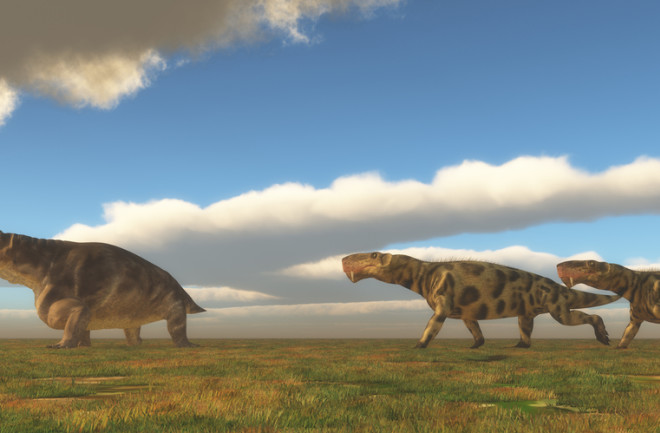Mass extinctions are evolutionary turning points — brief moments on a geologic time scale that drastically change the course of life on earth. One moment in particular stands out. The Permian-Triassic extinction, aka the Great Dying, eradicated more than 90 percent of earth’s marine species and 75 percent of terrestrial species 252 million years ago. It was the deadliest mass extinction event in the history of our planet, and its legacy lives on in the flora and fauna of the modern world.
The climactic and geochemical triggers for the Great Dying are unsettlingly similar to the effects of anthropogenic climate change. Global warming, ocean acidification and ozone layer-depletion caused ecological collapse.
The organisms that did recover from the extinction, did so slowly. Equatorial regions, which had been scorched beyond recognition, did not regain their characteristic biodiversity for five million years. Global ecosystems lacked both diversity and stability for at least eight million years following the event.
Survivors of the extinction event, though few, eventually repopulated the earth. These organisms are the ancestors of every living thing today. To paleontologists, the End-Permian Mass Extinction is the temporal boundary between the ancient paleozoic fauna and the modern fauna — a theoretical border between our world and a barely-recognizable predecessor.
Finding Precision
As recent as the late 2000s, the research community was significantly divided over what caused the Permian extinction. Some suggested that volcanism was at fault, while others suggested a meteor impact, like the one that wiped out the dinosaurs, caused the extinction.
Those that preferred the volcanic explanation, suspected the Siberian Traps, an expansive region of volcanic rock in present-day Siberia. The formation developed during an unrivaled period of volcanic rock on the ancient supercontinent Pangea.
“It’s the largest continental volcanic event and the largest mass extinction that we’re aware of on earth ever,” says Dr. Lindy Elkins-Tanton, a planetary scientist and professor at Arizona State University. “At the time, we didn’t know what caused either one or if they were definitively related to each other.”
In 2014, Chinese and American researchers made a breakthrough. The team extracted ancient volcanic ash from the Global Stratotype Section and Point for the early Triassic period, a site in Meishan, China that contains sediment that dates to the crisis unambiguously. By analyzing the uranium and lead isotopes contained in the ash, they put a relatively precise date on the extinction: 251.9 million years ago, give or take 70,000 years.
The next step was to date the Siberian Traps. Using the same method, the scientists analyzed samples from the site. “The bulk of this diffusive and explosive volcanism led up to the extinction,” says Elkins-Tanton, who was a part of the research team.
From these two dates, a timeline began to emerge. Intense volcanic activity on the ancient supercontinent of Pangea spewed magma through layers of basalt, coal and organic material. The combustion of these layers produced an immense amount of CO2 as well as other greenhouse gasses and chlorofluorocarbons.
Victims and Survivors
On land, both plants and animals perished in equatorial regions. At further latitudes, mosses and other lycopods began to dominate ecosystems that were once forested with conifers. Our ancestors, the tetrapods, died en masse. Survivors fled from the tropics towards the poles.
Like the mass extinctions before it, the End-Permian had an outsized impact on marine organisms. As CO2 from the atmosphere leached into the water, the ocean became more and more acidic. Simultaneously, high temperatures and cyanobacteria blooms consumed dissolved oxygen until there was little left.
Many organisms that had evolved to construct exoskeletons from minerals, found in ambient seawater, did not survive these changes in marine chemistry. The engineers of Permian reef ecosystems, rugose and tabulate corals, went completely extinct. Vast groups of externally-shelled cephalopods, ancestors of the nautilus, succumbed to the same fate. The End-Permian extinguished the last species of Trilobites as well, a group that had been on the decline since the Ordovician Mass Extinction.
Read more: The First Mass Extinction Event Explained: End-Ordovician
As with any mass-extinction, there were survivors of the Great Dying. Before the event, clam-like brachiopods were plentiful and diverse, but the extinction extinguished them in favor of their cousins, the bivalve mollusks. To this day, bivalves are widespread, while only a few orders of brachiopods remain.
Many researchers have speculated that the End-Permian may have catalyzed diversification among tetrapods. Though the extinction wiped many out permanently, the Early Triassic saw the creatures diversify and expand their ranges rapidly. This “radiation” eventually gave rise to archosaurs and later dinosaurs.
Drawing Parallels
The same factors that have driven anthropogenic global warming today drove global ecological collapse at the end of the Permian. An over-abundance of greenhouse gasses made the planet unlivable for most living organisms. Actually, the warming that initiated the End-Permian may have occurred at a much slower rate than anthropogenic global warming.
“It was the same climate change caused by the same greenhouse gasses as what we’re seeing today,” Elkins-Tanton says. “And it was almost the end of multicellular life on earth.”
However, climate scientists project that, if we can lower our emissions quickly enough, we can keep global warming to levels far below the ones that scorched the earth during the earth’s largest extinction event. It’s not too late to avoid total and complete ecological collapse.
“The rate of change might not have been as fast as today, but it changed the temperature so much that it’s really the worst-case scenario of what might happen,” David Bottjer says, paleoecologist and University of Southern California professor of earth sciences. “That’s why we should study it. To understand future scenarios for our climate.”
The future scenario, most-analogous to the End-Permian, would see humans continue to burn fossil fuels until few surviving organisms remained. It’s a scenario that may not represent the end of life on earth, but a fundamental change that would take millions of years to rebound from.

